Local Info
Moving To Charleston, SC? Here’s What It’s Like To Live There
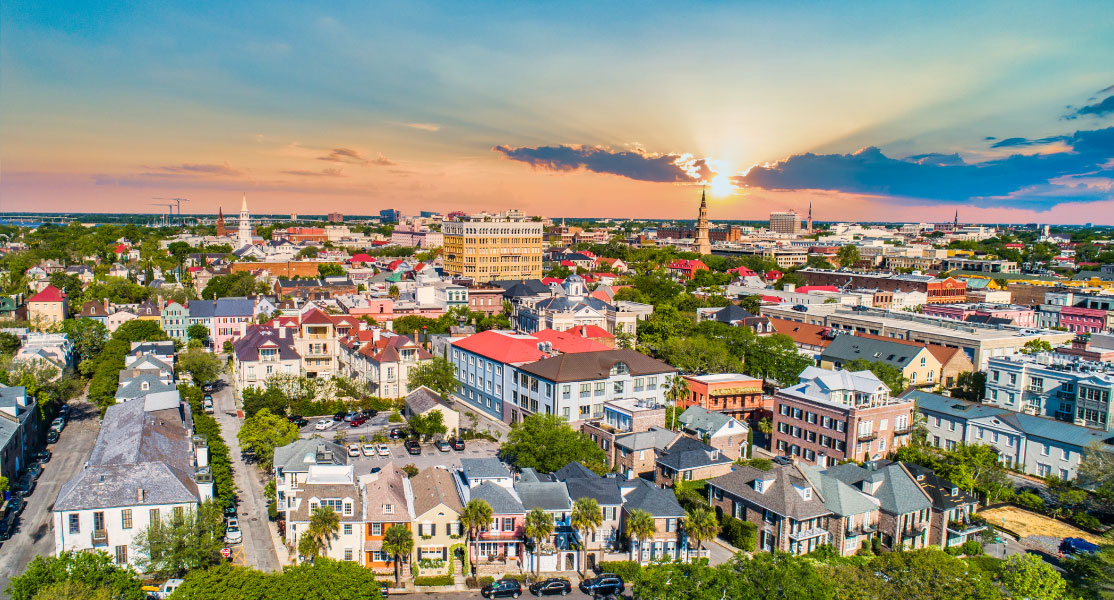
Charleston is South Carolina’s oldest and largest city and there’s a lot to choose from among the best things to do here. Charleston has several museums to explore that detail the city’s rich history and culture – of which not all is good. Rather than the skyscrapers that dominate most US city skylines, Charleston’s attractive skyline is dominated by church spires. With plenty of museums, bars, historic structures, and a pretty harbor, the city attracts a diverse mix of history buffs, partygoers, families, and fans of fishing.
You could spend weeks exploring the immaculately preserved Downtown and Charleston Harbour areas. But there are plenty of highlights that make a quick visit of a day or 2 to this enchanting city well worthwhile.
Few cities can match the charm that makes up Charleston: a mix of rich history that flavors the streets, shops, and people, and a vibrant influx of growth and innovation that keeps this Lowcountry city fresh and lively.
For the tourists that flock to the seaside destination each year, that means a vacation with nearly endless sightseeing and recreational options, from the French Quarter to Fort Sumter. And for the nearly 12,000 people moving to the Charleston region every year, it means choosing a culturally abundant city with award-winning dining, a thriving arts community, and plenty of choices when it comes to neighborhoods.
If you’re considering moving to Charleston, SC, read on for details to consider — including neighborhoods to check out, the cost of relocating, and where to find that storied Southern hospitality.
About Charleston, SC
From a bustling vibe in the historic district to the less-touristy but still busy ’burbs, Charleston can sometimes feel like a few cities in one. Cobblestone streets snake through downtown, where King Street galleries and upscale shops share real estate with boutique hotels and some of the best dining in the Southeast. Architectural gems appear on nearly every corner, along with colorful residences and the historic treasures that draw visitors from around the world. Near Charleston Harbor, in the neighborhood known as the Battery, elegant mansions sit high along the waterfront, with South Carolina’s signature palms lining the boulevards like stately sentries.
Did you know?
Charleston is nicknamed “The Holy City” because of the many steeples that stretch atop the skyline in every direction — a visual representation of the city’s history as a place of religious tolerance and diversity.
What drives the economy?
Tourism is the biggest moneymaker, but a dedicated effort to diversify the economy has also been largely successful. From 1990 to 2019, Charleston’s labor force grew by 66% and private sector employers by 73%, according to the Charleston Business Journal, helping to boost the population by almost 60% during the same period. Aerospace, automotive, defense, and technology are now top industries in the region, with the busy Port of Charleston serving as a key driver for the economic engine of the state. Several colleges and universities also call Charleston home, bolstering innovation and research opportunities.
Charleston’s diverse economy has kept the metro region afloat during the pandemic, according to experts at the 30th Annual Economic Outlook Conference, presented by the Charleston Metro Chamber.
Jacki Renegar, director of the Center for Business Research, and Alan Shao, dean of the School of College of Charleston reinforced the resilience of Charleston’s economy at the event, presenting data from key economic indicators that drive the region’s economy. They gave their predictions for 2021 and 2022 in the 2021 Economic Forecast (.pdf).
“Before the pandemic, the Charleston region had a healthy, thriving economy,” Renegar said. “It is this foundation that will allow for a quick recovery. There have been many great lessons and innovations that will improve the resiliency of our region and ensure a prosperous future.”
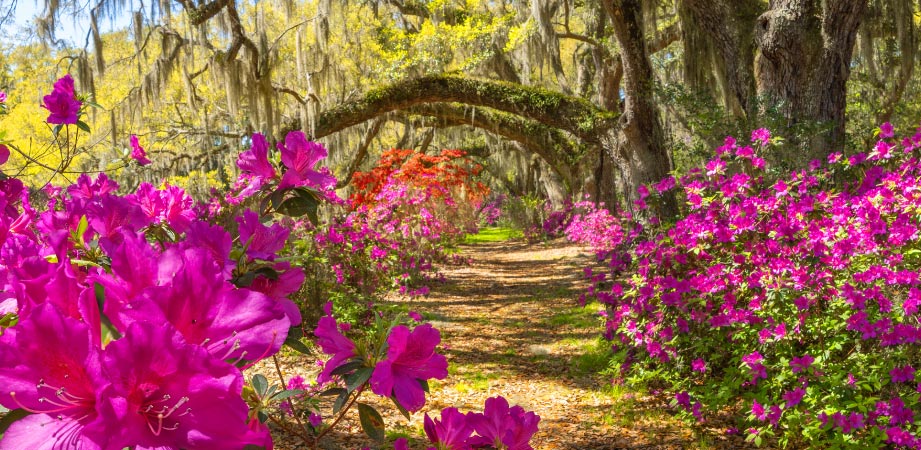
Magnolia Plantation and Gardens in Charleston, SC
How’s the weather?
Mild winters and hot, humid summers characterize Charleston, South Carolina, weather — with the occasional threat of a tropical disturbance barreling into town. Reminders of 1989’s monster Hurricane Hugo remain. But the damages and danger are easy to forget on a breezy summer day on one of the area’s half-dozen nearby barrier islands, with historic lighthouses dotting the shore and beachy villages offering a laid-back vacation atmosphere year-round.
Like most Southeastern U.S. destinations, Charleston measures the most rain during late summer, with thunderstorms rolling in like clockwork on many afternoons, for a total of about 50 inches a year. Temps can get downright toasty in the summer, reaching into the high 80s and low 90s. But all is forgiven in spring, when fragrant magnolias and jasmine scent the air and azaleas light up the city with their bright blooms in downtown courtyards.
What’s fun about Charleston?
Living in Charleston, South Carolina, you’ll never lack interesting things to do, whether you prefer history, wildlife, shopping, or the arts.
Family attractions include the Charleston Aquarium (or specifically, the South Carolina Aquarium), home to 5,000 creatures — from loggerhead sea turtles, the state’s official reptile, to flocks of coastal birds and a dizzying collection of sharks and other sea critters.
History buffs will want to explore Fort Sumter, the site of the first shots of the Civil War, and the Charleston Museum’s impressive masterworks collection for a deep dive into Lowcountry history. At the must-see Charleston City Market, you’ll find the usual touristy tchotchkes but also handmade treasures like Charleston’s signature sweetgrass baskets woven by Gullah artisans, descendants of West African slaves brought to the region in the 1500s.
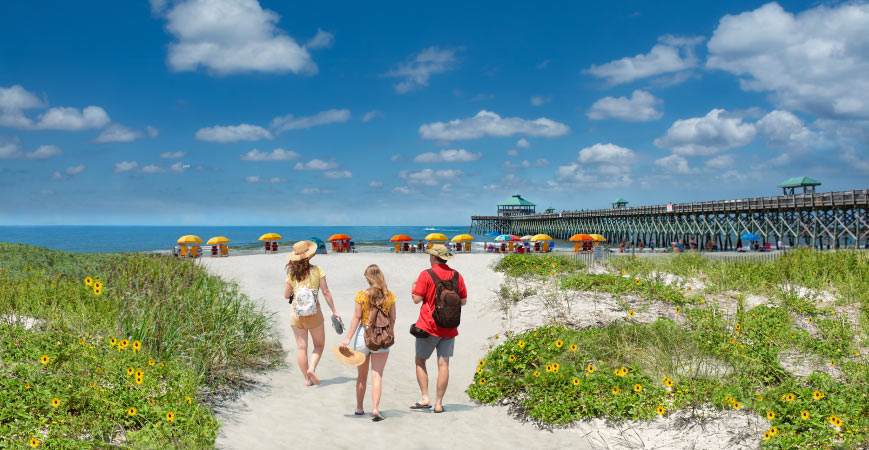
Folly Beach, South Carolina
Are there nice beaches near Charleston?
The Charleston area boasts some of the most beautiful beaches and parks you’ll find just about anywhere in the U.S. The city is dotted with greenspaces, including White Point Gardens, which occupies about six lush harborside acres near the Battery neighborhood.
Another beauty, the Joe Riley Waterfront Park, welcomes visitors to a covered pier, swings, and an esplanade along the Cooper River. Behind the park’s famous “Pineapple” fountain, you’ll find the entrance to the City Gallery, a contemporary art haven featuring the works of local, regional, and international artists.
Charleston’s beaches are legendary — not just for their place in history books as sites of Civil War battles, but for their soft sand, gorgeous surf-ready waves, and bounty of family recreation. Kiawah Island, site of world-class golfing and a top choice for retirees, is among the area’s preferred destinations, along with Isle of Palms, SC, and Sullivan’s Island.
Folly Beach, SC, just under a half-hour from downtown, is another favorite barrier island playground for out-of-state visitors and locals alike. Folly fits the bill as a true beach town, with charming independent eateries, shops, and open-air bars that create a celebratory atmosphere year-round. And annual festivals add to the fun — the Bill Murray Polar Bear Plunge, in honor of one of Charleston’s most famous residents, is a can’t-miss New Year’s Day tradition.
Is there a creative community in Charleston?
A lively local arts scene features local galleries, museums, and independent theater companies. Major music venues include the Gaillard Center, home to the Charleston Symphony Orchestra and Broadway tours. The Charleston Music Hall and smaller clubs and bars like the Pour House are popular spots for national bands and local favorites.
The world-famous Spoleto Festival draws the international arts community every year for visual exhibitions, theater, music, and more in a 17-day, city-wide event. In fact, since 1977, visitors have come from around the globe for the celebration, which is patterned after the Festival of Two Worlds in Spoleto, Italy. Guests through the years have included hundreds of performers, from Yo-Yo Ma to Renee Fleming, Nathaniel Raitliff and the Nightsweats to Brandi Carlile.
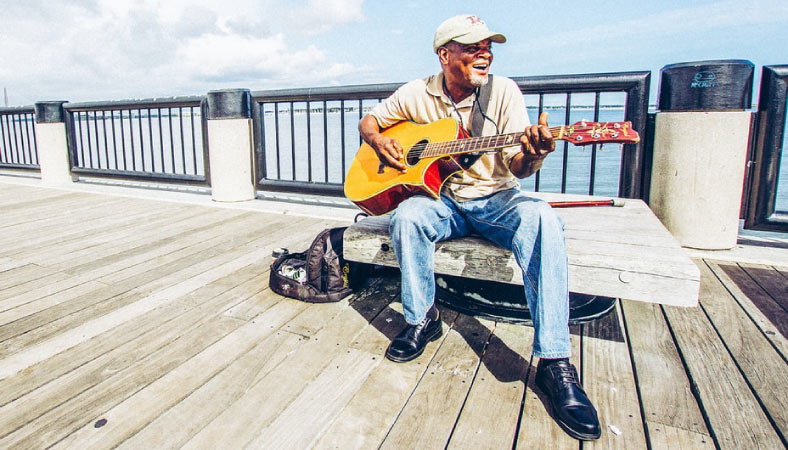
A local playing music on a boardwalk in Charleston, SC
Why do people move to Charleston, South Carolina?
For starters, a rich history, beautiful landscape, and a thriving dining scene are the attractions that draw new residents to move to Charleston. Travel + Leisure magazine readers agree, naming it the Top City in the U.S. for nine consecutive years and, in 2021, No. 18 on the Best Cities in the World list — the only American city to make the cut.
Here are a few more specific points to ponder if moving to Charleston is in your future:
Is Charleston, SC, an expensive place to live?
The cost of living in Charleston, SC, is 1.8% higher than the national average, according to Salary.com. Housing drives that differential, at about 15% more than the national average, with energy and food costs both nearly 13% below the norm. And typical home values are skyrocketing, as well, nearing $444,000 in November 2021 (an annual increase of over 23%).
Is traffic bad in Charleston?
Like any touristy favorite, Charleston can be a traffic nightmare near busy destinations. Rush hours get super congested downtown, where the streets are narrow and not designed for today’s volume of traffic. Bridges and routes to the beaches are equally clogged at certain times. But the average commuter in Charleston is looking at a 22.1-minute drive each way, compared to 26.4 for the national average.
Insider Tip:
Slow down! Horse-and-carriage rides are popular in downtown Charleston, and the city’s cobblestone streets aren’t made for multiple lanes of traffic. If you must drive, share the road. But better yet, hoof it.
What are the schools like in Charleston?
More than 50,000 students attend public schools in the Charleston County School District, which is rated in the top 20% of South Carolina districts. Consistently considered among the best public schools in Charleston is downtown’s Buist Academy, a K-8 magnet school specializing in the language arts. Competition is fierce, however; Buist’s acceptance rate, at 2.7%, is lower than those at Harvard (5%), Yale (6%), and MIT (8%). For older kids, Wando High School in Mount Pleasant, about 10 miles from downtown Charleston, is ranked No. 3 in the state by U.S. News & World Report.
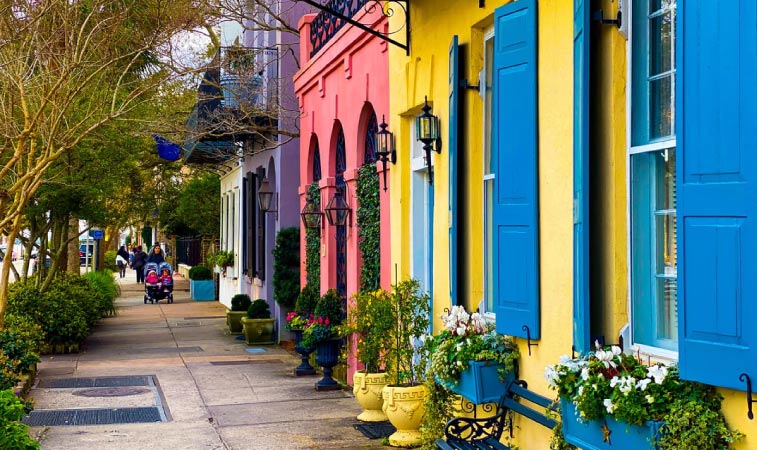
Rainbow Row in Charleston, SC
What is the best area to live in Charleston, SC?
In a city as culturally and geographically diverse as Charleston, picking a “best area” is difficult but not impossible — it just depends on your specific needs and wants in a neighborhood. Like most cities in the U.S., home prices have surged in the past couple of years. But folks looking to relocate to Charleston have plenty of areas to explore, with a range of costs and amenities — and all with a generous serving of Lowcountry flavor.
Here are a few highlights:
Downtown Charleston: Yes, downtown is touristy and crowded. It’s also 20 minutes from the Charleston airport — ideal for business travelers. And just as importantly, downtown is architecturally exquisite, with historic churches, upscale shopping, and world-class dining on practically every corner. Young professionals have discovered renovated (and pricey) condos and apartments in the historic district, but working families have been largely priced out of downtown real estate, with the notable exception of affluent neighborhoods near the Battery.
Mt. Pleasant, SC: As its name implies, this Charleston suburb hits all the right notes. A small but charming downtown area is within a stone’s throw from cozy neighborhoods of tree-lined streets and a variety of architectural styles. The usual suburban sprawl of chains and traffic has cropped up around the edges of Mount Pleasant, but overall the town is a picture-perfect haven for families.
Daniel Island: If you favor contemporary master-planned community living, Daniel Island is a good option. Situated on 4,000 acres about a half-hour north of downtown Charleston are nine distinctive neighborhoods, centered around a lively recreational lifestyle with miles of trails, tennis courts, golf, and swimming pools.
Summerville, SC: Founded as a seasonal getaway destination for city residents, Summerville is about a half-hour northwest of downtown Charleston. Today, its walkable downtown, terrific dining scene, and relatively affordable housing makes it a top choice for families year-round.
Did you know?
Summerville, known as Flowertown in honor of its wealth of beautiful gardens, is the birthplace of sweet tea — a Southern staple. www.summervillesc.gov
West Ashley: Charleston’s first bedroom community was built in the mid-century heyday of suburban flight, and it still retains the architectural styles of the era in many of its neighborhoods. Today, many West Ashley homes overlook the Intracoastal Waterway, with the 10-mile West Ashley Greenway snaking through the area and into Avondale, where restaurants, bars, and shops are the main attraction.
